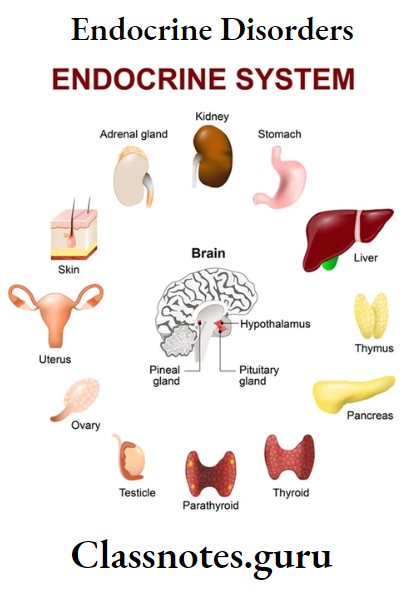Endocrine Disorders Important Notes
1. Addison’s Disease
- Occurs due to insufficiency of adrenal cortex hormone
- Manifested as pale brown to deep chocolate pigmentation of oral mucosa spreading to the buccal mucosa, gingiva, tongue, and lips
- Bronzing of skin
- Hypotension
- GIT disturbances occur
- Other features include lethargy, fatigue, muscular weakness, severe anemia
- Biopsy shows acanthosis with silver-positive granules in the cells of stratum germinativum
2. Gigantism And Acromegaly
- Occurs due to excessive secretion of growth hormone
- There is an increase in the number of granules in the acidophilic cells
- If the increase in granules occurs before the closure of the epiphysis of long bones, gigantism results
- If the increase occurs after epiphyseal closure acromegaly develops
- Gigantism occurs in children and acromegaly occurs in adults
- Acromegaly
- Lips become thick
- The tongue becomes enlarged and shows indentations on the side
- The mandible becomes large and macrognathic
- Mandibular teeth are buccally tipped
3. Hypophosphatemia
- Occurs due to deficiency of alkaline phosphatase enzyme in serum
- Oral manifestations are
- Formation of globular, hypocalcified dentin in the region of pulp horns
- Pulp horns are elongated
- Abnormal cementum
- Lamina dura is absent
Endocrine Disorders Short Essays
Question 1. Precautions to be taken during dental treatment of cardiac patients
(or)
Dental Considerations for Ischaemic Patients.
Answer:
Dental Considerations For Ischaemic Patients
- Ischaemic heart disease patients should be taken up for early appointments in the morning and not made to wait
- Patient with known diseases should be asked to carry their rescue medication
- In patients with moderate to severe angina, prophylactic nitroglycerine may be used 5 minutes before starting the dental procedure
- If a patient gets an acute episode of angina during a dental procedure
- Stop the dental procedure for a few minutes
- Administer tab nitroglycerine 0.5 mg sublingually
- Monitor pulse and BP
- If pain is not relieved in 8-10 minutes, the nitroglycerine dose may be repeated
Read And Learn More: Oral Medicine Question and Answers
Question 2. Hyperparathyroidism/Brown’s tumor.
Answer:
Hyperparathyroidism
- Hyperparathyroidism is an endocrine disorder occurring due to an excess of circulating parathyroid hormone
Brown’s Tumor Types:
- Primary Hyperparathyroidism: Occurring due to tumor of glands
- Secondary Hyperparathyroidism: Occurs in response to hypocalcemia
- Tertiary Hyperparathyroidism: Occurs after long-standing secondary hyperparathyroidism
Brown’s Tumor Clinical Features:
- Age And Sex – Common in middle-aged women
Brown’s Tumor Classic Triad:
- Kidney stones
- Bone resorption
- Duodenal ulcers
Brown’s Tumor Renal Symptoms:
- Renal calculi
- Hematuria
- Back pain
- Psychological symptoms – Emotionally unstable
- GIT symptoms – Anorexia, nausea, vomiting
Skeletal:
- Bone pain
- Pathologic fractures
- Bone deformities
- Hypercalcemia
Generalized Symptoms:
- Muscle weakness
- Fatigue
- Weight loss
- Insomnia
- Headache
- Polydipsia and polyuria
Oral Manifestations:
- Brown tumor – Intraoral/Extraoral swelling appears
Brown’s Tumor Teeth:
- Gradual loosening
- Drifting and loss of teeth
- Malocclusion
Brown’s Tumor Radiographic Features:
- Radiodensity-radiolucent lesion
- There may be a normal, granular, or ground-glass appearance
- Moth-eaten appearance with varying density
- Osteitis fibrosa generalisation – Localised bone destruction
- Brown tumor – represents ill-defined radiolucency
- Thinning of cortical tables
- Pepper pot skull
- Demineralization of the inferior border of the mandibular canal
- Thinning of outlines of the maxillary sinus
- Loss of lamina dura
Brown’s Tumor Management:
- Surgical – Hyperplastic tissue is removed
- Vitamin D – Oral administration of vitamin D
- Parathyroidectomy
- Restriction of dietary phosphate, phosphate binding agent, and aluminum salts
Question 3. Oral manifestations of diabetes mellitus.
(Or)
Diabetes Oral manifestations and dental management.
Answer:
Periodontium:
- Alter response of the periodontal lesion to local irritants
- Retards healing of tissues
- GCF contains more glucose
- Periodontal abscess formation
- Tooth mobility
- Severe and rapid bone resorption
Diabetes Oral manifestations Tongue:
- Altered taste sensation
- Median rhomboid glossitis
- Impaired local immune response
- Decreased Langerhans cell
Oral Candidiasis:
- Alveolar bone
- Localized osteitis
Diabetes Oral manifestations Mouth:
- Burning mouth sensation
- Dysgeusia
- Dysesthesia
- Xerostomia
- Increased caries activity
Diabetic Sialadenosis:
- Nerve: Diabetes neuropathy involving the trigeminal nerve
- Angular cheilosis
- Oral lichen planus
Dental Management:
- Acute musculoskeletal pain, painful dental lesions
- Patients with diabetes need to maintain very good oral hygiene as they are prone to odontogenic, periodontal, and other infections
- In well-controlled diabetics, dental procedures generally do not require any special precautions
- Antibiotic coverage may be required
- In uncontrolled diabetics, infections and wound healing may be a problem even after minor procedures
- If major dental procedures or surgery is to be undertaken, prior control of diabetes by the physician is needed
- If the patient is on only oral antihyperglycemic drugs, he should start insulin
- Dental procedures may often reduce food intake and diabetics may go to hypoglycemia
- Dose adjustments may be required
Question 4. Serum Sickness.
Answer:
Serum Sickness Causes:
- After the administration of foreign serum
- Tetanus antitoxin
- Rabies antiserum
Serum Sickness Mechanism:
- Antibodies form immune complexes in blood vessels with administered antigens
- These complexes fix complement which attracts the leukocytes to the area causing direct tissue injury
Serum Sickness Features:
- Fever
- Swelling
- Lymphadenopathy
- Joint and muscle pain
- Rash
- Peripheral neuritis,
- Kidney disease
- Myocardial ischemia
Question 5. Name 2 conditions with increased serum alkaline phosphate.
Answer:
2 Conditions With Increased Serum Alkaline Phosphate.
- Malignancy
- Abscess of liver
- Amyloidosis
- Leukemia
- Sarcoidosis

Endocrine Disorders Viva Voce
- Rapid weight loss with salt and water depletion is found in type 1 diabetes
- Chronic fatigue and malaise are found in type 2 diabetes
- Median rhomboid glossitis is a pathognomonic oral manifestation
